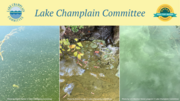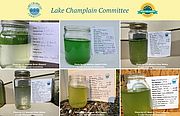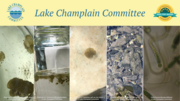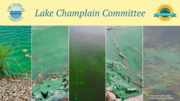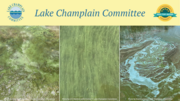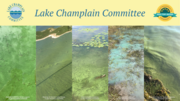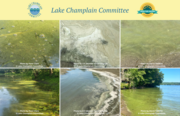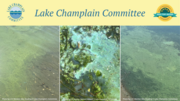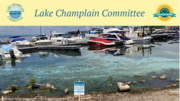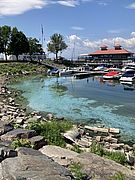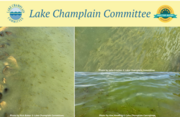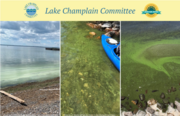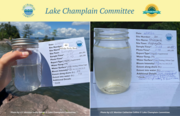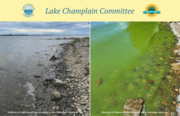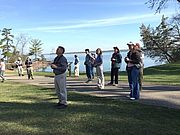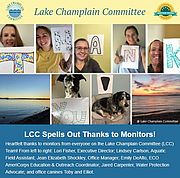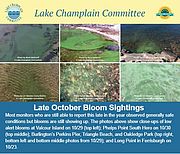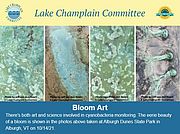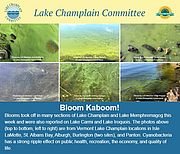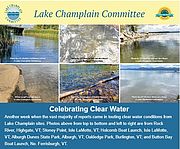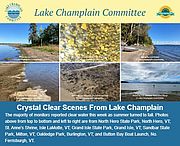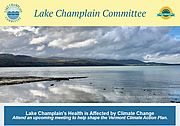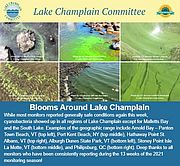While the weather cooled during Week 13 of monitoring, blooms continued in several lakes or bays where they were present previously and showed up in some new locations. On Lake Champlain, high alert conditions were restricted to nutrient-rich St. Albans Bay but there were low alerts in the Inland Sea, Malletts Bay, Main Lake North, and Main Lake South. Blooms also persisted in Lake Carmi, Lake Morey, and Lake Memphremagog. Read...
News from Selected Category
Throughout his career in the U.S. Senate, Patrick Leahy has been an unfailing champion for our region's– and the nation's – air, water, and land, and the health of our people. From the Conte National Wildlife Refuge, across the Green Mountain National Forest, to Lake Champlain, his dedication to safeguarding and investing in natural resources has improved our lives. Read...
Blooms continued into Week 12 of the monitoring season. You can see visuals of some of them from Lake Memphremagog, Lake Morey, Tinmouth Pond, Shelburne Pond and Lake Champlain’s Arnold Bay and Valcour Island, and Lake Champlain’s Keeler Bay. You’ll also find photos illustrating blue-green blues and the recreational impact of cyanobacteria. Read...
Several monitors reported odd gelatinous globules in the water at several sites in Lake Champlain’s Inland Sea during week 11 of monitoring. Happily they took water samples and photographs and shared the details with us and our partner Dr. Ana Morales-Williams at the University of Vermont’s Rubenstein Ecosystem Science Laboratory. The samples turned out to be Calothrix sp. – a benthic filamentous cyanobacteria. Read...
Happy end of August! As we move towards September, please remember that blooms can still happen as summer wanes which is why we are only about half way through the monitoring season. Blooms have been witnessed through November in our region during past years and the next few months can be very active periods for blooms. Read...
We’ve had a lot of additional subscribers to our weekly cyanobacteria emails so here’s a link to all the weekly reports from the 2022 season in case you’ve missed any of them. They’re worth checking out for the compilation of reporting results, visuals of blooms, and information to help you differentiate cyanobacteria from other lake phenomena. Read...
Happily, Central Main Lake was bloom-free during week 8 of monitoring but blooms persisted in sections of St. Albans Bay and Missisquoi Bay on Lake Champlain and Lake Carmi. After a week of bloom-free reports, cyanobacteria was observed again on Lake Memphremagog. Read...
Bloom reports for the week were restricted to the Central Main Lake, St. Albans Bay, and Missisquoi Bay on Lake Champlain and to Knapp Pond and Lake Carmi for Vermont inland lakes. Read...
Conditions at Lake Champlain and inland Vermont waterways were overall much improved from the previous week. Continued warm weather along with the influx of nutrients from periodic storms could trigger additional cyanobacteria blooms so check the water carefully during your recreational outings and take advantage of the resources and links in this email to learn more about cyanobacteria. Read...
Most of the week was sunny, hot, calm, and humid and blooms took off in many Lake Champlain locations as well as at Lake Carmi. Heat waves are known to promote cyanobacteria blooms in waterways by increasing thermal stratification, allowing cyanobacteria to remain in warm and well-lit surface waters, and encouraging release of phosphorus from lake sediments in shallow lakes. Read...
It's the season when cyanobacteria blooms are most prevalent. Learn how to recognize them by viewing this video produced in partnership with the Lake Champlain Committee (LCC). Read...
Our week 4 cyanobacteria monitoring report for July 10 through July 16 was delayed due to a breakdown with the cyanobacteria tracker. Monitors filed 187 reports during a busy week with blooms showing up in Lake Champlain’s Inland Sea, Main Lake North, Main Lake Central, and Main Lake South and at Lake Carmi and Lake Memphremagog while all other inland waterways reported good conditions. Read...
Another week of mainly good water conditions reported by over 100 monitors from Lake Champlain and inland lake locations. Blooms showed up in Lake Champlain’s Mallett’s Bay, North Lake, and Missisquoi Bay and on Lake Carmi and Lake Memphremagog.
We received mainly good water quality reports during the second week of the cyanobacteria monitoring program. Scroll through this email for details of Week 2 2022 monitoring results from 6/26/22 through 7/2/22; photos of clean water conditions at Lake Champlain’s Button Bay, Oakledge Park, North Beach, and Valcour Island; check out a cool monitor innovation for water sampling without getting wet; and learn about the ingredients for a bloom. Read...
Thank you for signing up to receive the Lake Champlain Committee (LCC) Cyanobacteria monitoring reports! Monitoring began the week of June 19 and will run through early fall. Each week we’ll send you an update about conditions monitors are finding around Lake Champlain and several inland lakes. Read...
It's summer time in the Champlain Valley which means spending time in and around your favorite lakes and ponds. Make sure you know how to asses water conditions! Read...
Happy Earth Day! Here are a few ideas for how to celebrate and protect our planet and the special corner we call home from your friends at the Lake Champlain Committee. Read...
The Lake Champlain Committee (LCC), Conservation Law Foundation (CLF), and Vermont Natural Resources Council (VNRC), have jointly filed a petition requesting that the Environmental Protection Agency (EPA) either force the State to correct its failed administration of the Clean Water Act or step in to regulate clean water enforcement in Vermont itself. Right now, the state’s Agency of Natural Resources and Agency of Agriculture both oversee clean water regulation on farms, a situation which leads to confusion and mistrust among farmers. Read...
Vermont is becoming warmer and wetter due to climate change. Specifically, the Vermont Climate Assessment 2021 notes that both summer and spring precipitation have increased in the Green Mountain State. The Assessment cautions that “[t]his spring precipitation . . . can make farm operations difficult.” Read...
In sun and rain, heat and cold, monitors collectively filed over 2,700 reports during the 2021 season. Read...
Most monitors reported generally safe conditions during this 19th week of the monitoring season but blooms were also witnessed at select locations. Read...
Wetlands are vital natural resources that must be protected and restored for Vermont to address the impacts of climate change, protect wildlife habitat, restore, and maintain the quality of our waters, and provide other benefits for people and nature. In light of their significance, we believe the state of Vermont must commit to a “net gain” of wetlands. Read...
While color is fading on the hillsides, it unfortunately is still showing up in the water. October 20 was a particularly busy day for cyanobacteria sightings with blooms reported at a scattering of locations up and down Lake Champlain. Scroll through this email to view pictures of the conditions witnessed at Arnold Bay, Burlington beaches, Island sites, St. Albans Bay, and Lake Memphremagog during this 18th week of cyanobacteria monitoring. You’ll also find some visuals and details about duckweed, water samples rimmed with cyanobacteria, and resources and links to help you recognize, avoid, and report cyanobacteria. Read...
Unfortunately, this was another big week for blooms—with reports of cyanobacteria coming in from all sections of Lake Champlain except Malletts Bay, Missisquoi Bay, and the South Lake. Blooms were also reported from Clyde Pond, Lake Carmi, Lake Iroquois, Lake Memphremagog, and Shelburne Pond. We have fewer monitors watching the water at this time of year but blooms can still show up as evidenced by the reports and photos compiled from this week. Please use the resources and links in this email to learn how to recognize, avoid, and report cyanobacteria. Read...
Unfortunately, this was a big week for blooms—reports of cyanobacteria were chronicled at all Lake Champlain sections except the South Lake and Malletts Bay. Blooms expanded in many areas of Lake Memphremagog and were reported on Lake Carmi and Lake Iroquois. You can get a sense of the impact of a bloom by watching this video taken on 10/6/21 by Missisquoi National Wildlife Refuge Manager Ken Sturm. Ken and his team witnessed an extensive swath of dense cyanobacteria in Missisquoi Bay during a 20-minute boat ride from the east delta all the way around to Long Marsh Bay. Read...
Monday, October 4th 2021
To the Vermont Climate Council,
...Significant parts of the world are literally on fire, and big portions of the rest of the nation are (or were recently) underwater. Vermont itself has recently missed being hit by not one but two massive tropical storms by mere miles, and earlier forecasts for the path of both Henri and Ida warned they might go directly through our state. And, of course, Vermonters are already experiencing more extreme heat and heavy precipitation events climate scientists have predicted for years. Read...
Clear water dominated on the cyanobacteria tracker during this first full week of fall and the 15th week of the cyanobacteria monitoring program. Most monitors who are still able to report recorded safe conditions, great for late-season recreation. Cyanobacteria was reported at one site each in Lake Champlain’s Main Lake Central and Main Lake South sections and several times during the week at Lake Carmi. Read...
Fewer reports are flowing in as we move into fall, park staff leave posts, and seasonal residents close up camps. However, late season blooms are not uncommon so please keep checking conditions whenever you recreate in or around water. Read...
The state of Vermont is developing its Climate Action Plan and drafters need your input to produce a forward-thinking guidance document that addresses the climate emergency. Seven events to gain public comments will be held throughout the state beginning tomorrow and running through early October. Read...
Although generally safe conditions dominated the cyanobacteria tracker again this week, we received reports of cyanobacteria from all Lake Champlain regions except the South Lake and Malletts Bay. Monitors also logged in bloom reports for some sites on Lake Carmi and Lake Memphremagog. Read...

